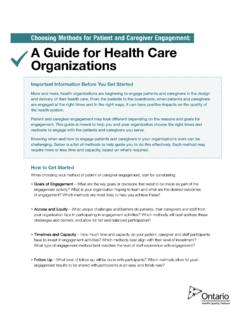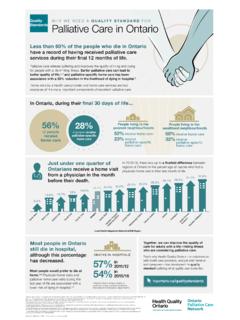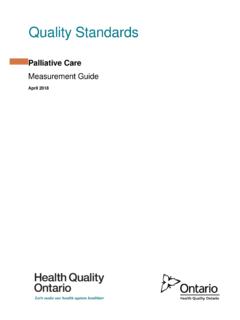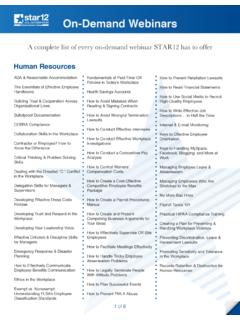Transcription of Quality Improvement Primers - HQOntario
1 Teamwork PrimerQuality Improvement PrimersACKNOWLEDGEMENTSThis workbook is the result of the efforts of the Health Quality Ontario (HQO) For additional information about other resources, contact: Health Quality Ontario may reproduce these materials for their use provided that proper attribution is given to the appropriate source. The recommended citation for this resource guide is: Health Quality Ontario (April 2013).HQO is funded by the Ontario Ministry of Health and Long-Term Care (MOHLTC). The opinions expressed in this publication are those of the authors and do not reflect the official views of the Ministry. Queen s Printer for Ontario, 2013 Teamwork Primer | Health Quality Ontario 3 Table of ContentsTeamwork Primer.
2 4 The Power of a Team ..4 Team Size ..5 Team Composition and Roles ..5 Elements of a successful team ..6 Trust ..7 Team Norms ..7 How to Create Team Norms ..8 How to Use Team Norms ..8 Intervening When Team Norms Are Not Being Used ..8 Shared Vision ..8 Clear Roles and Responsibilities ..9 Creating Clear Roles and Responsibilities ..9 Effective Communication ..9 Structured Team Meetings ..10 Preparation ..10 Norms ..10 Attitudes ..10 Communication ..11 Stages of Team Development ..11 Facilitating Teams through the Stages of Team Development ..12 Five Steps to Motivating Teams ..12 Conflict Styles ..144 Teamwork Primer | Health Quality OntarioTEAMWORK PRIMER Quality Improvement (QI) initiatives have the best chances of success when there is strong organizational leadership, a supportive culture of Improvement and team work, and staff that are familiar with Quality Improvement methodology.
3 A well-designed QI initiative includes frontline, inter-professional teams that are empowered to: set goals for Improvement , identify causes of poor system Quality , conduct tests of change, and collect and analyze data to determine whether a change led to Improvement . Once the decision to conduct a QI initiative has been made, one of the first steps in the Getting Started phase of Health Quality Ontario s QI Framework is to assemble a team that will use Quality Improvement science to achieve their goals. The Power of a Team Sometimes it may feel like the best way to achieve Quality Improvement would be if one person works alone to identify change ideas and implement the changes.
4 However, the essence of QI is to harness the knowledge, skills, experience and perspectives of a range of individuals, particularly customers and those individuals that are directly involved in or impacted by the process or service. Hospital physician specialist dictates note for patient record .Transcriptionist types out written document of dictation from specialist physician .Patient s family physician receives note from hospital specialist physician .The notion that 2+2 4 is particularly true for Quality Improvement initiatives. It is through collaboration, interaction and the building of relationships that sustainable change occurs.
5 Teams are most effective when: The system or process under consideration is complex The process involves more than one department or discipline Knowledge about all of the elements of the process cannot be held by only one person In an organization focused on Quality Improvement , everyone s daily activities include thinking about and implementing changes to continually improve health care delivery. To improve the process at right, at a minimum, the following people should be included in the QI team: the hospital specialist physician (provides input), the transcriptionist (performs a process step), and the family physician (receives an output).
6 <<Teamwork Primer | Health Quality Ontario 5 Resolving the problem will require the creativity to view it differently Employee commitment and buy-in are crucial to the success of the initiativeSince this list of qualities describes most QI projects, teams are recommended for all Quality Improvement initiatives. Team Size The following recommendations are helpful when considering how many team members are necessary: The team has to be big enough for tasks to be spread out so that no individual is overwhelmed The team has to be small enough that having meetings or communicating isn t too difficult With these criteria in mind, it is recommended that QI teams have between six and ten members.
7 Anything larger than ten can be difficult to manage and anything smaller than six may leave team members overwhelmed with work. Adjusting team size as the project evolves may be necessary, as well as creating small sub-teams for specific Composition and Roles Team composition should reflect where the process occurs and where the changes are being made. The team should include the professions and roles that touch the different parts of the process that is being considered for Improvement . This means the team should include staff members who: 1. Provide input to the process 2. Perform one or more of the process steps3. Receive output from the process Effective teams may also include members representing: 1.
8 Clinical or Process Expertise - The team s Clinical/Process Expert has first-hand knowledge and understands both the clinical implications of proposed changes and the consequences such a change might trigger in other parts of the system. 2 . A Data Lead The team s Data Lead has in-depth knowledge of data collecting, reporting and supporting systems. This individual has knowledge of available data sources, is able to extract relevant data, and can inform and support data collection processes. The Data Lead is able to help the team determine what to measure and can assist in the design of simple, effective performance measures to show whether a change is having a positive effect or not.
9 In addition, the Data Lead contributes by displaying metrics in a way that is both meaningful and easy to interpret by staff, visitors and Teamwork Primer | Health Quality Ontario3 . A Team Lead The Team Lead is responsible for managing the Quality Improvement project or initiative on a day-to-day basis. The Lead ensures that the goals of the project are achieved by guiding, supporting, directing, scheduling, and influencing other members of the QI team; clearing the path for the team to achieve success; helping the team to plan ahead; and encouraging the best from each team member. The Lead may have subject matter expertise as well as QI knowledge and experience.
10 As the driver of the project, the Lead makes sure that tests are implemented and works with the Data Lead on the collection of supporting data. This person should be knowledgeable about the processes and systems being improved, and be able to work effectively with other disciplines, including physicians. The Team Lead and Improvement Facilitator have different functions, so to take on both roles can be confusing and overwhelming. Thus, teams may choose to designate an individual to manage the team who is not the Improvement Facilitator. 4 . The End-User or Customer Any Quality Improvement initiative is designed to improve the Quality of whatever product or service is being delivered to your customer.














